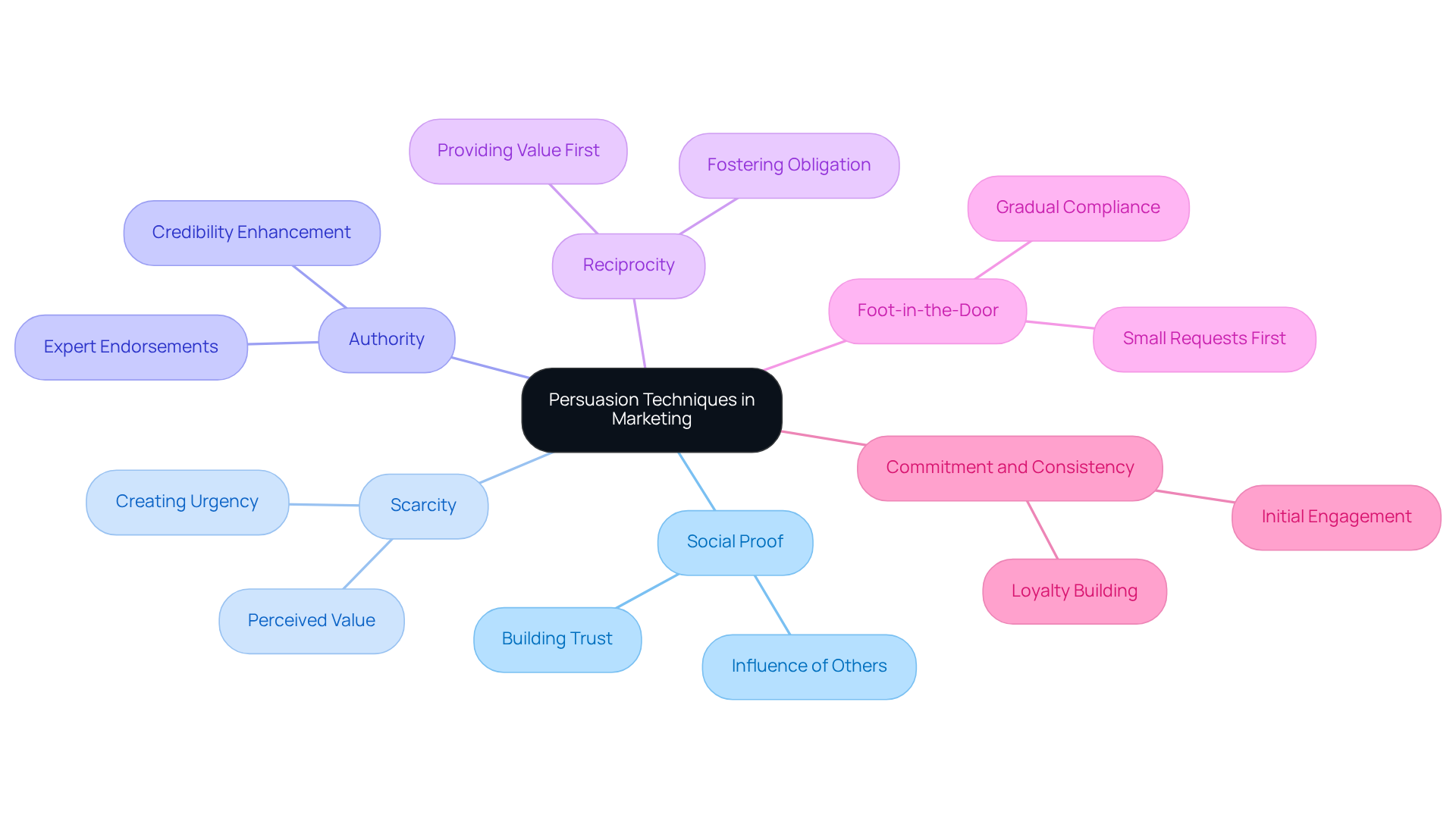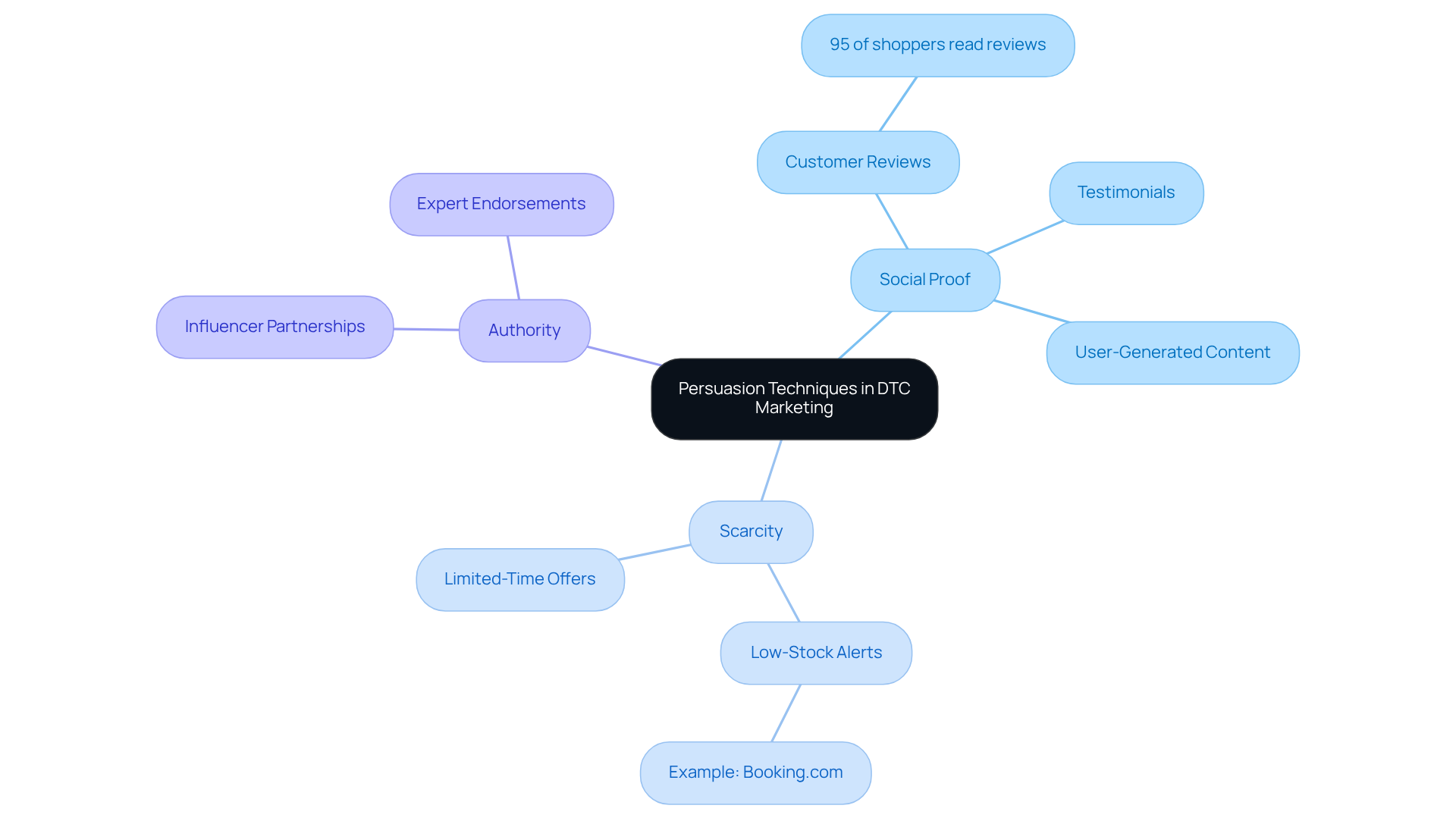
Overview
Persuasion techniques in marketing represent strategic methods crafted to influence consumer behavior, leveraging psychological principles that motivate actions such as purchases or subscriptions. This article delineates essential techniques, including:
- Social proof
- Scarcity
- Authority
- Reciprocity
Each technique's effectiveness is underscored through historical context and modern applications, collectively bolstering brand credibility and driving conversions. By understanding these principles, marketers can enhance their strategies and achieve greater success in influencing consumer decisions.
Introduction
Understanding the intricacies of consumer behavior is paramount for any brand poised to excel in a competitive marketplace. Persuasion techniques stand as formidable tools for Direct-to-Consumer (DTC) brands, empowering them to shape purchasing decisions and cultivate enduring customer loyalty. Yet, amidst a plethora of strategies, how can brands adeptly leverage these techniques to resonate with their target audiences and drive conversions?
This article explores the:
- Definition of persuasion techniques
- Historical context of persuasion
- Defining characteristics of persuasion techniques
It provides insights and practical applications that can revolutionize marketing strategies and enhance brand engagement.
Define Persuasion Techniques in Marketing
In marketing, what are persuasion techniques that represent strategic approaches designed to influence consumer behavior and decision-making? These methods utilize psychological principles to motivate potential clients to undertake specific actions, such as making a purchase or subscribing to a newsletter. Key persuasion techniques include:
- Social Proof: This technique leverages the influence of others' opinions and behaviors to establish trust and credibility.
- Scarcity: By creating a sense of urgency through limited availability, marketers can enhance perceived value. Research indicates that individuals fear losses 2.5 times more than they appreciate equivalent gains, making scarcity a potent motivator.
- Authority: Establishing credibility through endorsements or expert opinions significantly enhances trustworthiness.
- Reciprocity: This principle encourages action by first providing something of value, fostering a sense of obligation. The case study 'Reciprocity: Give to Get' illustrates how initial value provision can lead to increased customer loyalty.
- Foot-in-the-Door Technique: Initiating with a small request before escalating to larger ones can effectively lead to greater compliance over time.
- Commitment and Consistency Principle: Once individuals commit to a company, their likelihood of remaining loyal increases, underscoring the importance of initial engagement.
By comprehensively understanding what are persuasion techniques and effectively employing these methods, marketers can craft compelling messages that resonate with their target audience, ultimately driving conversions and fostering brand loyalty. The impact of these persuasion strategies is profound, influencing not only immediate purchasing decisions but also shaping long-term consumer relationships. A deep understanding of the target audience is crucial for the successful application of these methods, ensuring that promotional efforts are both relevant and effective.

Explore the Historical Context of Persuasion Techniques
The roots of what are persuasion techniques extend back to ancient civilizations, where rhetoric was essential for leaders and philosophers. Aristotle's principles of persuasion—ethos, pathos, and logos—demonstrate what are persuasion techniques that continue to influence modern marketing strategies. As trade progressed, so did the techniques of persuasion, adjusting to the shifting environment of buyer interaction. The advent of mass media in the 20th century opened new avenues for marketers, enabling them to reach broader audiences and refine their approaches. This period witnessed the rise of advanced advertising methods that utilized emotional appeals and social validation to influence purchasing behavior.
In modern digital marketing, what are persuasion techniques has been transformed through data analytics and insights into buyer psychology. Marketers now tailor their messages based on behavioral data, enhancing the effectiveness of their campaigns. For instance, case studies from Parah Group reveal that a $30M apparel company improved its conversion rate by 35% after redesigning its homepage to highlight social proof and reviews, gamifying the progress bar for free shipping thresholds, and introducing a free gift over a certain cart size. Likewise, Grab Green, a $15M cleaning product company, experienced an 80% rise in average order value (AOV) by applying strategic pricing, bundling options, and highlighting value propositions on larger items, demonstrating how effective persuasion techniques can influence purchasing behavior and improve profitability.
Furthermore, the ethical use of scarcity, such as limited-time offers, can effectively motivate consumer action when aligned with genuine brand values. However, caution against 'fake scarcity' is essential to maintain trust. Expert insights highlight the significance of understanding what are persuasion techniques in developing persuasive promotional strategies. As Maria Alonso, an award-winning strategist in promotion, observes, 'Persuasion is both art and science—but above all, it’s a reflection of how well we understand people.' This understanding is crucial for brands aiming to resonate with their audiences and foster long-term relationships, illustrating the enduring relevance of Aristotle's principles in today's marketing landscape.

Identify Key Characteristics of Effective Persuasion Techniques
What are persuasion techniques built on? They are based on several fundamental characteristics: clarity, relevance, emotional appeal, and credibility. Clarity is crucial; it ensures that the message is easily understood by the audience. Relevance connects the message to the audience's specific needs and desires, making it more impactful. Emotional appeal is particularly significant, engaging consumers on a deeper level and allowing them to relate personally to the message. This connection can be enhanced through storytelling and evocative imagery, which evoke feelings that resonate with the audience's experiences.
For instance, Coca-Cola's Christmas commercials effectively use nostalgic imagery to create emotional connections with viewers. Additionally, design elements such as color psychology and typography play a vital role in influencing emotional responses, with blue often associated with trust and red evoking excitement. Lastly, credibility is vital for establishing trust, often achieved through testimonials, expert endorsements, or data-backed claims. Chris Morse emphasizes that credibility enhances persuasion, as individuals are more likely to be persuaded by those they perceive as credible.
By incorporating these traits into their promotional strategies, companies can craft convincing messages that not only connect with their audience but also encourage desired actions, ultimately boosting engagement and loyalty. However, marketers must also be aware of the potential risks of emotional advertising, as seen in the backlash against Pepsi's controversial commercial. Thus, preserving authenticity in emotional appeals is crucial, reflecting the entity's true values and missions. By integrating these components, companies can effectively utilize emotional appeal in their promotional efforts.

Apply Persuasion Techniques in DTC Marketing Strategies
To effectively implement what are persuasion techniques in DTC marketing strategies, companies must prioritize the creation of personalized experiences that resonate with their target audience. Utilizing social proof—such as customer reviews, testimonials, and user-generated content—significantly enhances credibility and encourages new customers to make informed purchasing decisions.
Studies indicate that:
- 95% of shoppers read reviews prior to making a purchase.
- 88% of individuals trust user reviews similarly to personal recommendations.
This underscores the importance of displaying positive feedback to establish trust.
Furthermore, implementing scarcity tactics, such as limited-time offers or low-stock alerts, creates a sense of urgency, prompting quicker buying decisions. For instance, Booking.com effectively employs real-time notifications like '5 people are viewing this hotel,' tapping into the fear of missing out (FOMO) to encourage immediate action.
Additionally, companies can leverage authority by partnering with influencers or industry experts to promote their products, as endorsements from respected figures can elevate an organization's status and enhance consumer trust. However, it is crucial to exercise caution against over-reliance on social proof, as it may undermine authenticity.
By integrating what are persuasion techniques into their marketing strategies, DTC brands can significantly improve conversion rates; studies show that social proof, which is a part of what are persuasion techniques, can increase conversions by up to 15%, while simultaneously fostering long-term customer loyalty.

Conclusion
Mastering persuasion techniques is essential for DTC brand owners who seek to influence consumer behavior effectively. These strategies, grounded in psychological principles, enable marketers to craft messages that resonate with their audience, driving immediate sales and fostering long-term loyalty. By leveraging methods such as social proof, scarcity, authority, and emotional appeal, brands can construct compelling narratives that not only motivate consumers to act but also forge deeper connections with them.
This article explores the historical context of persuasion techniques, tracing their evolution from ancient rhetoric to contemporary digital marketing. Key insights underscore the significance of clarity, relevance, emotional engagement, and credibility in developing effective marketing strategies. Case studies from successful brands exemplify how these techniques can be practically applied, showcasing their potential to enhance conversion rates and nurture enduring relationships with customers.
The importance of mastering persuasion techniques cannot be overstated. As consumer preferences evolve, brands must refine their strategies to remain relevant and authentic. By thoughtfully and ethically embracing these methods, DTC brands can not only elevate their marketing outcomes but also cultivate a loyal customer base that values genuine engagement.
Frequently Asked Questions
What are persuasion techniques in marketing?
Persuasion techniques in marketing are strategic approaches designed to influence consumer behavior and decision-making by utilizing psychological principles to motivate potential clients to take specific actions, such as making a purchase or subscribing to a newsletter.
What is the social proof technique?
Social proof is a persuasion technique that leverages the influence of others' opinions and behaviors to establish trust and credibility among potential customers.
How does the scarcity technique work?
The scarcity technique creates a sense of urgency through limited availability, enhancing perceived value. Research shows that individuals fear losses significantly more than they appreciate equivalent gains, making this a powerful motivator.
What role does authority play in persuasion?
Authority enhances trustworthiness by establishing credibility through endorsements or expert opinions, which can significantly influence consumer decisions.
What is the principle of reciprocity in marketing?
The principle of reciprocity encourages consumers to take action by first providing something of value, fostering a sense of obligation. This can lead to increased customer loyalty as illustrated in the case study 'Reciprocity: Give to Get.'
What is the foot-in-the-door technique?
The foot-in-the-door technique involves starting with a small request before escalating to larger ones, which can effectively lead to greater compliance over time.
How does the commitment and consistency principle affect consumer loyalty?
The commitment and consistency principle suggests that once individuals commit to a company, their likelihood of remaining loyal increases, highlighting the importance of initial engagement.
Why is understanding the target audience important for marketers?
A deep understanding of the target audience is crucial for successfully applying persuasion techniques, ensuring that promotional efforts are relevant and effective in driving conversions and fostering brand loyalty.
FAQs











